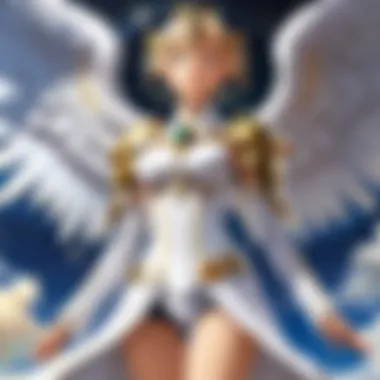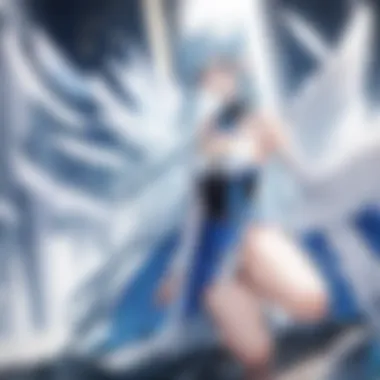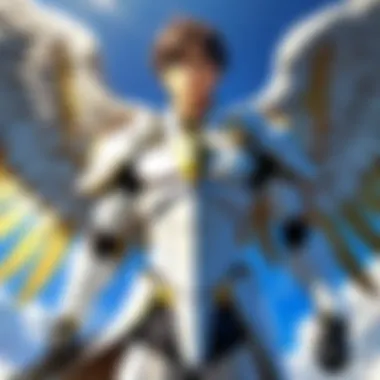Exploring the Concept of Seraph in Anime and Literature


Prolusion to the Series
The concept of seraph in anime and literature is a rich tapestry woven from historical influences, religious implications, and cultural reinterpretations. Seraphs, often depicted as celestial beings, carry deep symbolic meanings that resonate through various narratives. From ancient texts to modern storytelling, these entities evolve, reflecting societal values and individual struggles.
Overview of the Genre
Anime and literature provide a unique lens through which to view the notion of seraph. Often found within the realms of fantasy and supernatural genres, these stories explore themes of good versus evil, redemption, and existential dilemmas. Notable examples span across various series, highlighting how the portrayal of seraphs adapts to contemporary contexts.
Origins and Cultural Context
The term "seraph" derives from the Hebrew word for "burning ones," indicating their origins in religious texts, notably the Bible. In these texts, seraphs serve as guardians and messengers, often embodying divine attributes. As this concept migrated into popular culture, particularly in anime and literature, it became a versatile archetype. This adaptability demonstrates the fluidity of cultural narratives, allowing seraphs to mirror an array of societal issues.
The Search for Relevance
The exploration of seraphs in storytelling often unveils their relevance to modern audiences. They serve as a vehicle to confront personal and collective struggles, whether through themes of sacrifice, protection, or the quest for identity. As such, understanding the character of the seraph is essential for grasping the deeper meanings of these narratives.
Impact on Popularity and Reception
Series that feature seraphs have seen varied receptions, often marked by fan engagement and critical acclaim. Discussions on platforms like Reddit and forums dedicated to anime and literature shed light on the impact these portrayals have on audiences. The characters of seraphs invite dialogue about morality and humanity, fostering a connection that transcends the narrative.
"The seraph, as a figure, is not just another celestial being; it represents the complexity of existence and the duality of human experience."
The exploration of these celestial beings encourages viewers and readers alike to reflect on their own values and struggles, underscoring the enduring nature of the seraph's symbolism across time and culture.
Prologue to Seraph
The exploration of seraph manifests as a potent lens through which we can dissect varied narratives within anime and literature. This section aims to unpack its significance, shedding light on how these celestial beings reflect not only divine qualities but also the internal conflicts and societal values embedded in storytelling.
Focusing on the concept of seraph, we delve into its definition, characteristics, and historical context. Understanding these facets is essential as they establish a groundwork for appreciating the rich tapestry of associations related to seraphs across cultures and time periods.
Definition and Characteristics
The term seraph originates from the Hebrew word “saraph”, which means "to burn". This etymological root hints at the embodiment of purity, light, and the divine. In religious texts, seraphs are often described as high-ranking angels associated with the throne of God. They are atmospheric beings known for their fiery presence and are frequently depicted with multiple wings.
In both anime and literature, seraphs are characterized by their ethereal beauty, transcendence, and the complex duality of their existence. They often symbolize hope and deliverance, serving as guardians or guides in various narratives. Yet, their portrayal can sometimes parallel struggle and conflict, showing that even celestial beings are not exempt from moral dilemmas.
This duality offers writers a flexible framework to explore themes of redemption and sacrifice, which are integral to the human experience.
Historical Background
Historically, seraphs have occupied distinct roles in both religious scripture and mythology. In Judeo-Christian texts, their primary appearance is in the Book of Isaiah, where they attend to God's majesty and holiness. This sets a precedent for how seraphs are perceived in modern adaptations, ensuring that their initial connotation of divine purity remains.
In literature beyond religious confines, seraphs have evolved over centuries. They appear in Renaissance art, literature, and later, the rich narratives of anime, adopting new interpretations aligned with contemporary themes. Their historical evolution showcases a lineage of adaptation that reflects changing societal values, transforming from symbols of divine authority to complex characters involved in human-like struggles.


As we move forward in this article, we can examine how these definitions and historical contexts interact with cultural portrayals of seraphs, particularly in popular anime. By doing this, we enhance our understanding of the characters and their roles within these stories.
Cultural Significance of Seraphs
The cultural significance of seraphs transcends mere appearances in literature and anime. They serve as powerful symbols that embody complex themes such as morality, divinity, and the human condition. Their representation reflects the cultural and spiritual landscapes of various societies. In this section, we examine how seraphs are perceived across different cultures and the roles they play in shaping narratives.
Religious Interpretations
In various religious texts, seraphs are often depicted as celestial beings positioned close to the divine. In Christianity, for instance, they are described in the book of Isaiah as beings of purity and light. This high status gives them a crucial role in the heavenly hierarchy. Their function often encompasses worship and service to God, suggesting an ideal of moral excellence.
Many anime and literary works draw upon these religious interpretations, infusing the character of the seraph with moral dilemmas. These characters often wrestle with notions of good and evil, which reflects the struggles of humanity. For example, in some narratives, seraph characters guide humans, offering wisdom while confronting their own insecurities. This adds depth to their depiction and emphasizes the ongoing battle between light and darkness within individuals.
Mythological Connections
Beyond religious contexts, seraphs have roots in various mythologies, serving as symbols of transformation and change. Their characteristics resonate with several other celestial beings found in different cultures. For instance, in certain traditions, they share qualities with angels, guardians, or even fate-dealing entities.
This mythological richness allows authors and creators to play with the concept of seraphs, using them as vessels for deeper themes. The intersection of these various beliefs creates a tapestry of interpretations, each unique yet contributing to a broader understanding of seraphs as embodiments of hope and the quest for purpose. By connecting these threads, we can observe how seraphs enrich narratives and offer insight into the human experience, making their portrayal increasingly relevant.
Seraph in Anime
The depiction of seraphs in anime serves as a vital link between ancient mythology and contemporary storytelling. This section explores how these celestial beings embody themes of purity, conflict, and transformation. Anime often emphasizes their characteristics to navigate complex emotional narratives. Such representations make seraphs not just characters but symbols that resonate with audiences. By examining their portrayal, we gain deeper insights into cultural values and the human condition.
Representation of Seraphs
In anime, seraphs often manifest as ethereal beings with divine traits. These characters can reflect various aspects, such as moral dilemmas and the struggle between good and evil. Their appearances typically evoke a sense of purity and strength. For instance, they may be featured with wings and other distinct features that reinforce their celestial nature.
Moreover, the storytelling around seraphs often delves into their existential conflicts. They are shown grappling with their roles—whether they should adhere to divine mandates or embrace their humanity. The tension in these narratives encourages viewers to reflect on their own ethical beliefs and personal struggles.
Case Study: Notable Anime Featuring Seraphs
Anime Title One: "Seraph of the End"
"Seraph of the End" provides a unique take on the seraph concept. It dives into themes of survival and sacrifice. The seraph in this anime represents hope in a world dominated by darkness. The character’s development shows a transition from savior to a more complex being who questions their purpose.
The key characteristic that stands out in "Seraph of the End" is its focus on the duality of human nature. The seraph must navigate relationships and conflicts that reveal underlying human emotions. This complexity makes it a beneficial choice for discussing the role of seraphs in storytelling. However, the anime does face criticism for pacing and character development, which might mislead viewers about the profundity of its themes.
Anime Title Two: "Neon Genesis Evangelion"
In "Neon Genesis Evangelion," the concept of seraphs also appears, albeit in a more abstract form. Here, the seraph-like entities symbolize the struggle between mankind and greater forces. The story examines psychological and philosophical themes, making seraphs crucial to its narrative depth.
The unique feature of these beings in "Neon Genesis Evangelion" is how they challenge both the heroes and the audience's perceptions of divinity and humanity. This approach encourages viewers to engage with profound questions about existence and conflict. However, the complexity and layered storytelling can be overwhelming for some, which may obscure the takeaway message regarding the essence of seraphs in human and divine existence.
Character Analysis
In the study of seraphs within anime and literature, character analysis plays a crucial role. It allows us to unpack the layers of these celestial beings and how they connect with broader themes of morality, identity, and conflict. By analyzing seraph characters, we gain insight into their purpose within the narrative and the impact they have on other characters and the audience itself.


Benefits of Understanding Characterization:
- Deepen Appreciation: Knowing the intricacies of seraph characters fosters a deeper appreciation for their complexity.
- Contextual Insight: Provides context for their actions, motivations, and transformations in the storyline.
- Cultural Reflection: Highlights how these characters reflect and shape societal values and conflicts.
Seraph characters often embody ideals such as purity, compassion, and sacrifice. However, they also can display flaws and vulnerabilities. This duality makes them compelling subjects for character analysis, as they mirror human emotions and struggles.
Archetypes of Seraph Characters
Seraph characters in anime and literature often follow specific archetypes. Understanding these archetypes reveals how creators use them to convey different messages. Common archetypes include:
- The Guardian: Often portrayed as a protector, this type of seraph represents safety and unwavering support.
- The Fallen: This archetype explores the theme of betrayal and redemption, showcasing the struggle between good and evil.
- The Nurturer: This character embodies care and love, often guiding other characters on their journeys.
- The Avenger: Representing justice, these seraphs seek retribution and often face moral dilemmas.
Each archetype serves a distinct purpose in advancing the narrative and engaging the audience.
Evolution of Seraph Characters in Modern Narratives
The portrayal of seraph characters has undergone considerable changes in modern narratives. Initially depicted as solely benevolent forces, today's narratives explore more complex representations. Some notable trends include:
- Moral Ambiguity: Modern seraphs often grapple with ethical dilemmas, reflecting real-world complexities of morality.
- Personal Struggles: They are depicted with deeper emotional layers, allowing the audience to relate more closely to their experiences.
- Nuanced Relationships: Unlike earlier representations, contemporary seraph characters often have intricate relationships with humans, showcasing interdependence and conflict.
The evolution of these characters mirrors our understanding of spirituality and humanity. By studying this evolution, we can appreciate how seraphs adapt to fit the themes of modern storytelling.
Narrative Functions of Seraphs
The narrative functions of seraphs in anime and literature serve a significant role in enriching stories and character arcs. These celestial beings often embody complex ideologies, acting as catalysts for change and embodying moral quandaries. The representation of seraphs helps to navigate the intricate themes of good, evil, redemption, and sacrifice. In essence, they reflect not only the internal struggles of characters but also the societal values of the cultures from which they originate.
Seraphs provide a framework for authors to convey deeper meanings within a narrative. The way they are integrated into a story can influence character motivations and plot directions profoundly. Understanding the narrative functions of seraphs offers insight into the broader implications of their roles. It allows for a comprehensive analysis of how such beings impact the themes they embody and the transformations they initiate in others.
Symbolism of Redemption and Sacrifice
The symbolism of redemption and sacrifice often materializes vividly through the portrayal of seraphs. These characters frequently grapple with the dilemma of their existence and its impact on humanity. A common thread in stories featuring seraphs is the idea of selflessness; they often sacrifice their own interests for the welfare of others. This theme resonates deeply in many narratives, particularly in anime where personal struggle is a recurring motif.
In various narratives, a seraph's journey toward redemption commonly embodies themes like forgiveness and internal conflict. These celestial beings may act as guides for other characters, illuminating paths toward reconciliation or personal growth. By sacrificing themselves or their power, they emphasize the importance of making difficult choices for the greater good. Furthermore, such actions often serve as a commentary on the human experience, reflecting the struggle to rise above one’s flaws and mistakes.
"The seraphic figure is not merely a symbol of purity; it also represents the transformative power of regret and redemption within storytelling."
Conflict and Resolution Roles
Seraphs play pivotal roles in the conflicts and resolutions that unfold in many anime and literary narratives. They are often placed in positions where they must confront antagonists or opposing forces. This conflict serves to showcase their strengths, weaknesses, and moral compass. The way seraphs handle these confrontations can reveal the underlying themes of the narrative, such as the balance between light and darkness.
In the context of resolution, seraphs frequently emerge as pivotal resources for resolution in the plot. Their presence can catalyze important changes within other characters, encouraging them to confront their fears or reassess their values. Their conflict with darker forces often leads to a potential redemption arc for other characters, illustrating the broader theme of hope.
Thematic Elements Surrounding Seraphs
The thematic elements surrounding seraphs play a crucial role in shaping the narrative and cultural significance of these celestial beings. Within the context of anime and literature, these themes reflect deep philosophical questions and human experiences. The exploration of themes, such as the struggle between good and evil and the intersection with human emotions, enriches the portrayal of seraphs and enhances the overall storytelling experience. Through their symbolic representation, seraphs can illustrate the complexities of morality and personal growth that resonate with audiences.


Exploration of Themes such as Good vs. Evil
The theme of good versus evil is prevalent in many narratives involving seraphs. This duality creates a captivating conflict that not only drives the plot but also prompts viewers and readers to contemplate moral dilemmas. Seraphs, often depicted as divine beings, embody the ideals of purity and virtue. However, narratives frequently challenge their role as mere paragons of light. By placing seraphs in situations where they must confront dark forces or corrupt individuals, the stories reveal the nuanced nature of morality.
In many anime and literary works, the seraphs are not just warriors fighting against evil; they are also catalysts for the protagonists’ inner struggles. By presenting seraphs in morally ambiguous situations, these stories invite audiences to question the nature of good and evil.
Intersections with Human Emotions
The representation of seraphs often intertwines with human emotions, offering a rich exploration of themes such as love, sacrifice, and redemption. These celestial figures are frequently portrayed as guardians or guides, as they navigate through the complexities of human experience. Their interactions with human characters allow for a deep emotional connection that transcends the traditional boundaries of their divine nature.
Stories that incorporate seraphs often highlight the emotional burdens faced by characters. For instance, the unconditional love of a seraph can bring comfort to those in despair, while the weight of sacrifice might illustrate the personal cost of righteousness. This thematic depth adds layers of meaning to the narrative, making it more relatable and impactful.
"Seraphs not only exemplify divine will but also engage in the very human experiences of love, loss, and redemption."
In summary, the thematic elements surrounding seraphs enhance both their complexity and relevance in modern storytelling. By examining good versus evil and the profound connections to human emotions, audiences gain a richer understanding of these celestial beings and their place in anime and literature.
Comparative Analysis of Seraphs Across Cultures
The concept of seraphs varies significantly across different cultural frameworks. This comparative analysis is vital because it highlights the diversity in representation and invocation of seraphs, emphasizing how cultural contexts influence their narratives. Understanding these nuances can provide insights into societal values and the human condition as depicted through these celestial beings. Each culture's interpretation of seraphs can reflect its unique worldview, religious beliefs, and philosophical considerations. This section will illustrate how distinguishing these cultural representations can enrich our understanding of seraphs in literature and anime.
Eastern vs. Western Depictions
Eastern and Western depictions of seraphs manifest distinct characteristics and roles in narratives. In Western tradition, particularly within Christian theology, seraphs are often seen as the highest order of angels. They are associated with divine light, love, and purity. This representation emphasizes their role as mediators between God and humans, often showcasing them in a highly reverent aura. Their features typically include multiple wings and a radiant presence, symbolizing their closeness to the divine.
In contrast, Eastern depictions, especially within certain strands of Buddhism and Hinduism, frame seraph-like entities differently. Here, celestial beings might symbolize enlightenment or spiritual journey rather than a direct mediation role with a deity. They often embody the principles of compassion, wisdom, and the quest for ultimate truth. Characters may possess supernatural abilities, which indicate their transcendence rather than solely reflecting divine authority. This suggests a broader spectrum of roles and responsibilities attributed to similar entities across cultures.
"The portrayal of seraph-like figures reflects not only artistic choices but profound cultural narratives shaping how society views divinity and morality."
Impact of Cultural Context on Representation
Cultural context profoundly shapes the representation of seraphs, affecting their functions in narrative structures and character development. In Western media, seraphs might be portrayed as guardians or warriors of faith, often depicted in a battle between good and evil. This narrative aligns with the prevailing themes in many anime and literary works, where conflict drives the plot forward. The struggles they undergo often reflect the human experience of overcoming adversity.
On the other hand, Eastern narratives may prioritize introspection and the philosophical implications of being a celestial being. Seraphs or seraph-like figures in this context are often involved in personal journeys or quests for spiritual awakening. The conflicts they face tend to be internal, exploring themes like the nature of existence and the search for enlightenment. This difference underscores the array of thematic storytelling present in both cultures while maintaining the essence of what seraphs represent.
Ending
The conclusion serves as a vital component of this article, summarizing the multifaceted concept of seraphs as depicted in anime and literature. It emphasizes the intricate relationship between these celestial beings and various narrative threads, highlighting how their characterization impacts the storytelling landscape. Key insights presented throughout the article reveal that seraphs often embody themes of redemption, sacrifice, and human emotion, allowing audiences to connect with the narrative on a personal level.
In reviewing the cultural significance of seraphs, one can see how these figures appear across different societies, representing a blend of religious and mythological elements. Their roles shift according to the cultural context, demonstrating adaptability and resilience in the face of changing societal values. This adaptability is not just a testament to their origins but also points to their ongoing relevance in contemporary narratives.
Recap of Key Insights
- The concept of seraphs transcends boundaries, emerging from religious roots into mainstream media.
- Representation in anime often reflects societal struggles, such as the quest for identity and the nature of sacrifice.
- The evolution of seraph characters shows their ability to engage audiences through archetypal dynamics and complex emotional narratives.
These points encapsulate how seraphs provide depth in storytelling, making them essential subjects for analysis.
The Enduring Relevance of Seraphs in Modern Culture
Seraphs continue to resonate in modern culture, showing a flexibility that aligns with contemporary issues. Whether in the realm of anime or literature, these beings symbolize a bridge between the celestial and the human experience. Their portrayal often encourages exploration of fundamental questions about morality, existence, and the human condition.
Moreover, seraphs appear in popular media, not only as traditional figures of good but also as characters grappling with moral ambiguities. This shift allows for richer narrative frameworks that mirror current societal challenges. Thus, understanding seraphs is essential to grasp the thematic undercurrents that shape modern storytelling. As their representation evolves, so does their significance, ensuring that they remain relevant in a rapidly changing cultural landscape.















